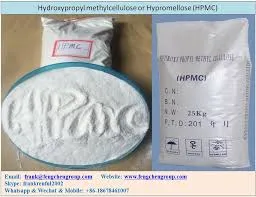
Th10 . 01, 2024 21:28 Back to list
Synthesis Techniques and Strategies for HPMC Development in Pharmaceutical Applications
HPMC Synthesis An Overview and Applications
Hydroxypropyl methylcellulose (HPMC) is a non-ionic, water-soluble polymer derived from cellulose. It is widely used in various industries due to its unique properties, including thickening, emulsifying, and stabilizing capabilities. The synthesis of HPMC involves the modification of cellulose through a series of chemical reactions, which allows for the integration of hydroxypropyl and methyl groups into the cellulose backbone. This article explores the synthesis of HPMC, its properties, and its diverse applications.
The synthesis of HPMC begins with cellulose, which is extracted from natural sources such as wood or cotton. The first step involves the mercerization of cellulose. During this process, cellulose fibers are treated with a strong alkaline solution, typically sodium hydroxide, to create alkali cellulose. This treatment causes the cellulose fibers to swell and increases their reactivity, making it easier to introduce the hydroxypropyl and methyl groups.
HPMC Synthesis An Overview and Applications
Once the etherification process is complete, the resultant HPMC can be precipitated from the solution, washed, and dried to obtain the final product. The powdered HPMC can then be ground and classified according to different particle sizes, making it suitable for various applications. The final product's characteristics, such as viscosity and solubility, can be tailored by adjusting the proportions of the reactants and the reaction conditions.
hpmc synthesis

HPMC possesses several properties that make it valuable across various industries. Its ability to form gels and films, combined with its stability under heat and alkaline conditions, renders it ideal for use in pharmaceuticals, food products, construction materials, and personal care items. In the pharmaceutical field, HPMC is commonly used as a binder, disintegrant, and coating agent in tablet formulations. Its controlled release properties are particularly beneficial for modulating drug release rates, enhancing patient compliance.
In the food industry, HPMC acts as a thickening agent and stabilizer in sauces, dressings, and baked goods, improving consistency and texture. It is also utilized in gluten-free products, providing necessary binding properties without the presence of gluten.
Additionally, HPMC is increasingly used in the construction industry, especially in dry-mix mortars, where it enhances workability and water retention, leading to improved durability and performance of building materials.
In the realm of personal care, HPMC finds its way into lotions, creams, and hair products due to its ability to create a smooth, spreadable texture, acting as both an emulsifier and thickener.
In conclusion, the synthesis of HPMC opens the door to a wide range of applications spanning multiple industries. Its versatile properties make it a critical ingredient in formulations requiring enhanced texture, stability, and performance, underscoring its importance in both commercial and consumer products. As industries continue to innovate, the demand for HPMC is expected to grow, solidifying its role as a fundamental polymer in modern applications.
-
Versatile Hpmc Uses in Different Industries
NewsJun.19,2025
-
Redispersible Powder's Role in Enhancing Durability of Construction Products
NewsJun.19,2025
-
Hydroxyethyl Cellulose Applications Driving Green Industrial Processes
NewsJun.19,2025
-
Exploring Different Redispersible Polymer Powder
NewsJun.19,2025
-
Choosing the Right Mortar Bonding Agent
NewsJun.19,2025
-
Applications and Significance of China Hpmc in Modern Industries
NewsJun.19,2025







